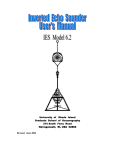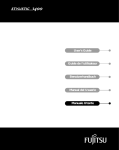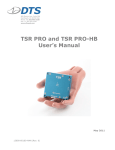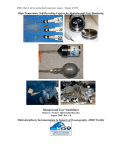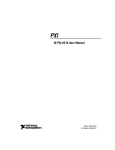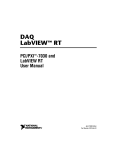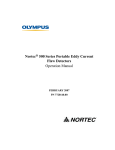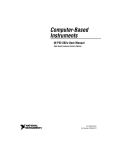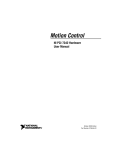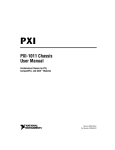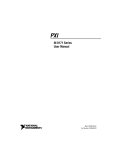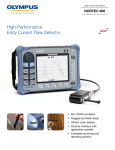Download PCI-7041 User Manual - National Instruments
Transcript
PCI PCI-7041 User Manual PCI-7041 User Manual October 2002 Edition Part Number 373360A-01 Support Worldwide Technical Support and Product Information ni.com National Instruments Corporate Headquarters 11500 North Mopac Expressway Austin, Texas 78759-3504 USA Tel: 512 683 0100 Worldwide Offices Australia 03 9879 5166, Austria 0662 45 79 90 0, Belgium 02 757 00 20, Brazil 55 11 3262 3599, Canada (Calgary) 403 274 9391, Canada (Montreal) 514 288 5722, Canada (Ottawa) 613 233 5949, Canada (Québec) 514 694 8521, Canada (Toronto) 905 785 0085, China 86 21 6555 7838, Czech Republic 02 2423 5774, Denmark 45 76 26 00, Finland 09 725 725 11, France 01 48 14 24 24, Germany 089 741 31 30, Greece 01 42 96 427, Hong Kong 2645 3186, India 91 80 4190000, Israel 03 6393737, Italy 02 413091, Japan 03 5472 2970, Korea 02 3451 3400, Malaysia 603 9596711, Mexico 001 800 010 0793, Netherlands 0348 433466, New Zealand 09 914 0488, Norway 32 27 73 00, Poland 22 3390 150, Portugal 210 311 210, Russia 095 238 7139, Singapore 65 6 226 5886, Slovenia 3 425 4200, South Africa 11 805 8197, Spain 91 640 0085, Sweden 08 587 895 00, Switzerland 056 200 51 51, Taiwan 02 2528 7227, United Kingdom 01635 523545 For further support information, see the Technical Support and Professional Services appendix. To comment on the documentation, send email to [email protected]. © 2002 National Instruments Corporation. All rights reserved. Important Information Warranty The PCI-7041 is warranted against defects in materials and workmanship for a period of one year from the date of shipment, as evidenced by receipts or other documentation. National Instruments will, at its option, repair or replace equipment that proves to be defective during the warranty period. This warranty includes parts and labor. The media on which you receive National Instruments software are warranted not to fail to execute programming instructions, due to defects in materials and workmanship, for a period of 90 days from date of shipment, as evidenced by receipts or other documentation. National Instruments will, at its option, repair or replace software media that do not execute programming instructions if National Instruments receives notice of such defects during the warranty period. National Instruments does not warrant that the operation of the software shall be uninterrupted or error free. A Return Material Authorization (RMA) number must be obtained from the factory and clearly marked on the outside of the package before any equipment will be accepted for warranty work. National Instruments will pay the shipping costs of returning to the owner parts which are covered by warranty. National Instruments believes that the information in this document is accurate. The document has been carefully reviewed for technical accuracy. In the event that technical or typographical errors exist, National Instruments reserves the right to make changes to subsequent editions of this document without prior notice to holders of this edition. The reader should consult National Instruments if errors are suspected. In no event shall National Instruments be liable for any damages arising out of or related to this document or the information contained in it. EXCEPT AS SPECIFIED HEREIN, NATIONAL INSTRUMENTS MAKES NO WARRANTIES, EXPRESS OR IMPLIED, AND SPECIFICALLY DISCLAIMS ANY WARRANTY OF MERCHANTABILITY OR FITNESS FOR A PARTICULAR PURPOSE. CUSTOMER’S RIGHT TO RECOVER DAMAGES CAUSED BY FAULT OR NEGLIGENCE ON THE PART OF NATIONAL INSTRUMENTS SHALL BE LIMITED TO THE AMOUNT THERETOFORE PAID BY THE CUSTOMER. NATIONAL INSTRUMENTS WILL NOT BE LIABLE FOR DAMAGES RESULTING FROM LOSS OF DATA, PROFITS, USE OF PRODUCTS, OR INCIDENTAL OR CONSEQUENTIAL DAMAGES, EVEN IF ADVISED OF THE POSSIBILITY THEREOF. This limitation of the liability of National Instruments will apply regardless of the form of action, whether in contract or tort, including negligence. Any action against National Instruments must be brought within one year after the cause of action accrues. National Instruments shall not be liable for any delay in performance due to causes beyond its reasonable control. The warranty provided herein does not cover damages, defects, malfunctions, or service failures caused by owner’s failure to follow the National Instruments installation, operation, or maintenance instructions; owner’s modification of the product; owner’s abuse, misuse, or negligent acts; and power failure or surges, fire, flood, accident, actions of third parties, or other events outside reasonable control. Copyright Under the copyright laws, this publication may not be reproduced or transmitted in any form, electronic or mechanical, including photocopying, recording, storing in an information retrieval system, or translating, in whole or in part, without the prior written consent of National Instruments Corporation. Trademarks LabVIEW™, MITE™, National Instruments™, NI™, ni.com™, NI-DAQ™, NI-VISA™, RTSI™, and SCXI™ are trademarks of National Instruments Corporation. Product and company names mentioned herein are trademarks or trade names of their respective companies. Patents For patents covering National Instruments products, refer to the appropriate location: Help»Patents in your software, the patents.txt file on your CD, or ni.com/patents. WARNING REGARDING USE OF NATIONAL INSTRUMENTS PRODUCTS (1) NATIONAL INSTRUMENTS PRODUCTS ARE NOT DESIGNED WITH COMPONENTS AND TESTING FOR A LEVEL OF RELIABILITY SUITABLE FOR USE IN OR IN CONNECTION WITH SURGICAL IMPLANTS OR AS CRITICAL COMPONENTS IN ANY LIFE SUPPORT SYSTEMS WHOSE FAILURE TO PERFORM CAN REASONABLY BE EXPECTED TO CAUSE SIGNIFICANT INJURY TO A HUMAN. (2) IN ANY APPLICATION, INCLUDING THE ABOVE, RELIABILITY OF OPERATION OF THE SOFTWARE PRODUCTS CAN BE IMPAIRED BY ADVERSE FACTORS, INCLUDING BUT NOT LIMITED TO FLUCTUATIONS IN ELECTRICAL POWER SUPPLY, COMPUTER HARDWARE MALFUNCTIONS, COMPUTER OPERATING SYSTEM SOFTWARE FITNESS, FITNESS OF COMPILERS AND DEVELOPMENT SOFTWARE USED TO DEVELOP AN APPLICATION, INSTALLATION ERRORS, SOFTWARE AND HARDWARE COMPATIBILITY PROBLEMS, MALFUNCTIONS OR FAILURES OF ELECTRONIC MONITORING OR CONTROL DEVICES, TRANSIENT FAILURES OF ELECTRONIC SYSTEMS (HARDWARE AND/OR SOFTWARE), UNANTICIPATED USES OR MISUSES, OR ERRORS ON THE PART OF THE USER OR APPLICATIONS DESIGNER (ADVERSE FACTORS SUCH AS THESE ARE HEREAFTER COLLECTIVELY TERMED “SYSTEM FAILURES”). ANY APPLICATION WHERE A SYSTEM FAILURE WOULD CREATE A RISK OF HARM TO PROPERTY OR PERSONS (INCLUDING THE RISK OF BODILY INJURY AND DEATH) SHOULD NOT BE RELIANT SOLELY UPON ONE FORM OF ELECTRONIC SYSTEM DUE TO THE RISK OF SYSTEM FAILURE. TO AVOID DAMAGE, INJURY, OR DEATH, THE USER OR APPLICATION DESIGNER MUST TAKE REASONABLY PRUDENT STEPS TO PROTECT AGAINST SYSTEM FAILURES, INCLUDING BUT NOT LIMITED TO BACK-UP OR SHUT DOWN MECHANISMS. BECAUSE EACH END-USER SYSTEM IS CUSTOMIZED AND DIFFERS FROM NATIONAL INSTRUMENTS' TESTING PLATFORMS AND BECAUSE A USER OR APPLICATION DESIGNER MAY USE NATIONAL INSTRUMENTS PRODUCTS IN COMBINATION WITH OTHER PRODUCTS IN A MANNER NOT EVALUATED OR CONTEMPLATED BY NATIONAL INSTRUMENTS, THE USER OR APPLICATION DESIGNER IS ULTIMATELY RESPONSIBLE FOR VERIFYING AND VALIDATING THE SUITABILITY OF NATIONAL INSTRUMENTS PRODUCTS WHENEVER NATIONAL INSTRUMENTS PRODUCTS ARE INCORPORATED IN A SYSTEM OR APPLICATION, INCLUDING, WITHOUT LIMITATION, THE APPROPRIATE DESIGN, PROCESS AND SAFETY LEVEL OF SUCH SYSTEM OR APPLICATION. Compliance FCC/Canada Radio Frequency Interference Compliance Determining FCC Class The Federal Communications Commission (FCC) has rules to protect wireless communications from interference. The FCC places digital electronics into two classes. These classes are known as Class A (for use in industrial-commercial locations only) or Class B (for use in residential or commercial locations). Depending on where it is operated, this product could be subject to restrictions in the FCC rules. (In Canada, the Department of Communications (DOC), of Industry Canada, regulates wireless interference in much the same way.) Digital electronics emit weak signals during normal operation that can affect radio, television, or other wireless products. By examining the product you purchased, you can determine the FCC Class and therefore which of the two FCC/DOC Warnings apply in the following sections. (Some products may not be labeled at all for FCC; if so, the reader should then assume these are Class A devices.) FCC Class A products only display a simple warning statement of one paragraph in length regarding interference and undesired operation. Most of our products are FCC Class A. The FCC rules have restrictions regarding the locations where FCC Class A products can be operated. FCC Class B products display either a FCC ID code, starting with the letters EXN, or the FCC Class B compliance mark that appears as shown here on the right. Consult the FCC Web site at http://www.fcc.gov for more information. FCC/DOC Warnings This equipment generates and uses radio frequency energy and, if not installed and used in strict accordance with the instructions in this manual and the CE Marking Declaration of Conformity*, may cause interference to radio and television reception. Classification requirements are the same for the Federal Communications Commission (FCC) and the Canadian Department of Communications (DOC). Changes or modifications not expressly approved by National Instruments could void the user’s authority to operate the equipment under the FCC Rules. Class A Federal Communications Commission This equipment has been tested and found to comply with the limits for a Class A digital device, pursuant to part 15 of the FCC Rules. These limits are designed to provide reasonable protection against harmful interference when the equipment is operated in a commercial environment. This equipment generates, uses, and can radiate radio frequency energy and, if not installed and used in accordance with the instruction manual, may cause harmful interference to radio communications. Operation of this equipment in a residential area is likely to cause harmful interference in which case the user will be required to correct the interference at his own expense. Canadian Department of Communications This Class A digital apparatus meets all requirements of the Canadian Interference-Causing Equipment Regulations. Cet appareil numérique de la classe A respecte toutes les exigences du Règlement sur le matériel brouilleur du Canada. Class B Federal Communications Commission This equipment has been tested and found to comply with the limits for a Class B digital device, pursuant to part 15 of the FCC Rules. These limits are designed to provide reasonable protection against harmful interference in a residential installation. This equipment generates, uses, and can radiate radio frequency energy and, if not installed and used in accordance with the instructions, may cause harmful interference to radio communications. However, there is no guarantee that interference will not occur in a particular installation. If this equipment does cause harmful interference to radio or television reception, which can be determined by turning the equipment off and on, the user is encouraged to try to correct the interference by one or more of the following measures: • Reorient or relocate the receiving antenna. • Increase the separation between the equipment and receiver. • Connect the equipment into an outlet on a circuit different from that to which the receiver is connected. • Consult the dealer or an experienced radio/TV technician for help. Canadian Department of Communications This Class B digital apparatus meets all requirements of the Canadian Interference-Causing Equipment Regulations. Cet appareil numérique de la classe B respecte toutes les exigences du Règlement sur le matériel brouilleur du Canada. Compliance to EU Directives Readers in the European Union (EU) must refer to the Manufacturer’s Declaration of Conformity (DoC) for information* pertaining to the CE Marking compliance scheme. The Manufacturer includes a DoC for most every hardware product except for those bought for OEMs, if also available from an original manufacturer that also markets in the EU, or where compliance is not required as for electrically benign apparatus or cables. To obtain the DoC for this product, click Declaration of Conformity at ni.com/hardref.nsf/. This Web site lists the DoCs by product family. Select the appropriate product family, followed by your product, and a link to the DoC appears in Adobe Acrobat format. Click the Acrobat icon to download or read the DoC. * The CE Marking Declaration of Conformity will contain important supplementary information and instructions for the user or installer. Conventions The following conventions are used in this manual: » The » symbol leads you through nested menu items and dialog box options to a final action. The sequence File»Page Setup»Options directs you to pull down the File menu, select the Page Setup item, and select Options from the last dialog box. This icon denotes a note, which alerts you to important information. This icon denotes a caution, which advises you of precautions to take to avoid injury, data loss, or a system crash. bold Bold text denotes items that you must select or click in the software, such as menu items and dialog box options. Bold text also denotes parameter names. italic Italic text denotes variables, emphasis, a cross reference, or an introduction to a key concept. This font also denotes text that is a placeholder for a word or value that you must supply. monospace Text in this font denotes text or characters that you should enter from the keyboard, sections of code, programming examples, and syntax examples. This font is also used for the proper names of disk drives, paths, directories, programs, subprograms, subroutines, device names, functions, operations, variables, filenames and extensions, and code excerpts. monospace bold Bold text in this font denotes the messages and responses that the computer automatically prints to the screen. This font also emphasizes lines of code that are different from the other examples. Contents Chapter 1 Introduction Overview........................................................................................................................1-1 Hardware Description ....................................................................................................1-2 Processor Board...............................................................................................1-2 I/O Daughterboard...........................................................................................1-5 Accessory Board..............................................................................................1-5 Communication to the Host.............................................................................1-5 CompactFlash ..................................................................................................1-6 Memory ...........................................................................................................1-6 Watchdog Timer..............................................................................................1-6 CPU Temperature Monitor..............................................................................1-6 LEDs................................................................................................................1-7 RTSI ................................................................................................................1-7 Serial Port ........................................................................................................1-7 Switches...........................................................................................................1-8 Battery .............................................................................................................1-9 National Instruments Software ......................................................................................1-9 Chapter 2 PCI-7041 Installation and Configuration PCI Installation ..............................................................................................................2-1 Accessory Board Installation...........................................................................2-2 Board Configuration ......................................................................................................2-3 Downloading Software to an Embedded System ............................................2-3 Embedded DAQ Configuration.......................................................................2-5 Locking System Configuration........................................................................2-5 Installing CompactFlash Memory .................................................................................2-6 Appendix A Specifications Appendix B LED Indicators © National Instruments Corporation vii PCI-7041 User Manual Contents Appendix C Technical Support and Professional Services Glossary Index PCI-7041 User Manual viii ni.com 1 Introduction This manual contains detailed instructions for installing and configuring the National Instruments PCI-7041. The PCI-7041 is a multifunction I/O board with an embedded processor. Use LabVIEW RT and NI-DAQ to create embedded, real-time applications that run on the PCI-7041. Overview The PCI-7041/6040 RT Series board is a plug-in PCI board with an embedded processor and measurement functionality. The PCI-7041, LabVIEW Real-Time (RT), and measurement software, such as NI-DAQ, provide an easy-to-use system for real-time applications. Three subcomponents make up the PCI-7041: the processor board, the I/O daughterboard, and the accessory board, as shown in Figure 1-1. The following section explains each subcomponent in further detail. © National Instruments Corporation 1-1 PCI-7041 User Manual Chapter 1 Introduction Figure 1-1. PCI-7041 RT Series Board Hardware Description Processor Board The PCI-7041 processor board is the platform on which LabVIEW RT executes. Figure 1-2 shows the major components of this board, including the following: PCI-7041 User Manual • A high-performance Pentium III microprocessor • An Intel 440MX chipset • SDRAM for main memory • Flash memory for the BIOS • CompactFlash for nonvolatile application and data storage • RS-232 serial port circuitry • An FPGA (Field Programmable Gate Array) • Two National Instruments miniMITE ASICs • Fast SRAM for communication to the host computer 1-2 ni.com Chapter 1 Introduction There are also several buses on the processor board, including the following: • GTL bus running at 100 MHz between the microprocessor and chipset • Memory bus running at 100 MHz between the chipset and SDRAM • Embedded PCI bus running at 33 MHz between the chipset, miniMITE B, and daughterboard • Host PCI bus running at a maximum of 33 MHz between the miniMITE A and the host system • IDE bus between the chipset and CompactFlash • ISA bus between the chipset and BIOS © National Instruments Corporation 1-3 PCI-7041 User Manual Chapter 1 Introduction Pentium III CPU Embedded ISA bus Serial Port BIOS Flash Processor Bus Memory Bus SDRAM IDE Bus Compact Flash 440MX chipset Embedded PCI bus Daughterboard miniMITE B Watchdog Board Registers FPGA FPGA Shared SharedMemory Memory Controller Controller Shared Memory SRAM miniMITE A Host PCI bus Figure 1-2. PCI-7041 Processor Board Diagram PCI-7041 User Manual 1-4 ni.com Chapter 1 Introduction I/O Daughterboard The PCI-7041 daughterboard provides the I/O functionality. The daughterboard is a National Instruments PXI device with some mechanical modifications to allow it to connect to the processor board. You can expect the same high performance and features from the daughterboard that you do from the standard version of the device. Refer to the LabVIEW Help, available by selecting Help»Contents and Index in LabVIEW, and Chapter 2, PCI-7041 Installation and Configuration, for more information about hardware and software configuration. Accessory Board The accessory board brings some I/O signals out from the PCI-7041. These include the following: • RS-232 serial port • SMB Watchdog timer • LEDs Use of the accessory board is optional. If you do not need any of the above I/O, you may leave the accessory board disconnected. Refer to the following sections for information about the serial port, watchdog timer, and LEDs. Communication to the Host The PCI-7041 communicates with the host computer by way of shared memory. The shared memory is accessible from both the host PCI bus and the PCI-7041 embedded PCI bus. LabVIEW manages this shared memory and provides various methods for using it. For example, the PCI-7041 can be accessed as if it were a device on your network. LabVIEW exports the PCI-7041 to the network on which the host computer resides. This means that LabVIEW functions such as VI server and TCP/IP will work with the PCI-7041. The PCI-7041 can even act as a Web server to send data across the Internet. You also can access the shared memory directly using the shared memory VIs in LabVIEW. Refer to the LabVIEW RT User Manual for more information about communicating with the PCI-7041. © National Instruments Corporation 1-5 PCI-7041 User Manual Chapter 1 Introduction CompactFlash The PCI-7041 has a CompactFlash module for nonvolatile application and data storage. You can store LabVIEW VIs on the CompactFlash. These VIs can optionally be made to execute at startup. You also can log data to the CompactFlash. Refer to the LabVIEW RT User Manual for more information about configuring startup applications. Memory The main memory on the PCI-7041 is a single 144-pin SO-DIMM that is socketed for easy upgrade. You can replace the SO-DIMM that ships with the PCI-7041 with up to 128 MB of 10 ns SDRAM. For information about adding RAM by replacing the SO-DIMM, refer to Appendix A, Specifications. Watchdog Timer The PCI-7041 features a programmable timer known as a watchdog. You can use the watchdog timer to monitor your LabVIEW application and trigger an alert if something causes the software to stop running. In such a case, you may need to alert the operator and shut down equipment to protect people and machines. The watchdog lights an LED to signal that a problem has occurred, optionally resets the board, and optionally asserts the watchdog I/O signal on the accessory board. The I/O signal can be programmed to be high or low asserted or open collector. The watchdog works as follows: You initially choose a timeout period longer than your software loop time. The timer starts counting, and your software must continually reset the watchdog before the timeout period elapses. Each time the counter is reset, it starts counting again at the beginning. If the counter reaches the timeout period, which happens because the software is hung and cannot reset the counter, the watchdog expires and takes the actions it was configured to take. For more information, refer to the LabVIEW RT User Manual. CPU Temperature Monitor The CPU (Pentium III microprocessor) temperature is monitored in hardware. If the temperature exceeds the CPU’s rated operating temperature range, the board goes into reset and remains there until the power is cycled. An LED also lights to indicate what has happened. This condition should not occur as long as the board is operated within its specified operating range, and as long as the CPU fan is running. For more information, refer to Appendix A, Specifications. PCI-7041 User Manual 1-6 ni.com Chapter 1 Introduction LEDs Six LEDs on the accessory board report the PCI-7041 status. They are as follows: • POWER (PWR)—Lights when the board is powered on and has come out of reset • Drive (HDD)—Lights when the CompactFlash is accessed • Watchdog (WD)—Lights when the watchdog timer has expired, which indicates a problem has occurred with the software • CPU Temperature Monitor (TMP)—Lights if the CPU temperature exceeds its safe operating range and the board is in reset • USER 1 (1)—Available for your own use • USER 2 (2)—Available for your own use Refer to the LabVIEW RT User Manual for more information about programming these LEDs. RTSI The real-time system integration (RTSI) bus directly connects measurement devices for precise synchronization of functions. The PCI-7041 provides all RTSI functionality. The RTSI bus allows you to connect the PCI-7041 to any other RTSI device regardless of whether the other device is an RT Series device or standard DAQ device. The RTSI connections are made with a connector on the top edge of the PCI-7041 and a RTSI cable available from National Instruments. Refer to your daughterboard user manual for information about how to use the RTSI signals. Serial Port The PCI-7041 has one serial port, available on the accessory board. It is a standard RS-232 serial port such as the one in your desktop computer. You can read and write to the port from within LabVIEW RT using NI-VISA. The NI-VISA resource name is ASRL1:INSTR. Refer to the LabVIEW RT User Manual for more information. © National Instruments Corporation 1-7 PCI-7041 User Manual Chapter 1 Introduction Switches There are three slide switches and one pushbutton switch on the PCI-7041. Figure 1-3 shows their location. The switches are labeled on the opposite side of the board. They are not accessible from outside the computer, so you must remove the computer cover to use them. ON No App OFF S1 Recover ON OFF S2 Redirect ON OFF S3 Reset (Push for 2 Seconds) Figure 1-3. PCI-7041 Switches The Reset pushbutton resets and reboots the board. To use the button, push it for at least two seconds and then release it. If you connect the accessory board to the PCI-7041, you can use the POWER LED to know how long to push the button. Hold in the button until the POWER LED goes out, then release the button. You also can reset the board from software on the host computer. Use whichever method is more convenient to reset the PCI-7041. Switch S1 is the No App switch. LabVIEW RT provides a way to load a startup application on the CompactFlash, which begins execution as soon as the board powers on and boots. The No App switch disables this startup PCI-7041 User Manual 1-8 ni.com Chapter 1 Introduction application. If the board is booted with the No App switch in the On (left) position (refer to Figure 1-3), no startup application runs. For more information on startup applications, refer to the LabVIEW RT User Manual. Switch S2 is the Safe Mode switch, referred to as the Recover switch on the board. Normally, the PCI-7041 boots and runs LabVIEW RT from the CompactFlash. If the CompactFlash becomes corrupted, the Safe Mode switch puts the board into safe mode, which allows you to reload the software onto the CompactFlash. To put the board into safe mode, set the Safe Mode switch to the On (left) position (refer to Figure 1-3) and reset the board. Switch S3 is the Redirect switch. Setting this switch to the On (left) position and resetting the board causes the PCI-7041 to output boot status and software status messages to the accessory board serial port. To view these messages, connect the serial port to your computer’s serial port via a serial crossover (null modem) cable. Use a terminal program such as Hyperterm and open a connection to the computer serial port with the following settings: 9,600 Baud, 8 data, 1 stop, no flow control. Be sure to set the Redirect switch to the Off (right) position (refer to Figure 1-3) if you plan to use the serial port for any reason other than to see these messages. Setting this switch to On causes the PCI-7041 to boot more slowly than normal. Battery The battery on the PCI-7041 keeps the clock running when the board is powered off. It is a sealed Lithium battery that should last five years or more. If you need to replace it, contact National Instruments. The battery manufacturer is Tadiran (www.tadiranbat.com), and the part number is TL-5186. National Instruments Software National Instruments has developed several software kits you can use with the PCI-7041. The software is already installed on your flash drive. The PCI-7041 is specifically designed to use LabVIEW RT. For more information, refer to the LabVIEW RT User Manual and the PCI E Series User Manual. © National Instruments Corporation 1-9 PCI-7041 User Manual PCI-7041 Installation and Configuration 2 This chapter contains instructions for installing and configuring the PCI-7041. Caution Electrostatic discharge can damage several components on the PCI-7041. To avoid such damage in handling the board, touch the antistatic plastic package to a metal part of your computer before removing the module from the package. Install LabVIEW Real-Time (RT) and NI-DAQ before you install the PCI-7041. Refer to Chapter 2, Installation, of the LabVIEW Real-Time User Manual for information about installing LabVIEW RT and NI-DAQ. Note PCI Installation Complete the following steps to install the PCI-7041. 1. Power off and unplug your computer. 2. Remove the computer cover. 3. Make sure there are no lit LEDs on the motherboard. If any are lit, wait until they go out before continuing the installation. 4. Remove the expansion slot cover on the back panel of the computer. 5. Insert the PCI-7041 into a 5 V or 3.3 V PCI slot. Gently rock the board to ease it into place. It might be a tight fit, but do not force the board into place. 6. Screw the mounting bracket of the PCI-7041 to the back panel rail of the computer. 7. Install the accessory board according to the Accessory Board Installation section (optional). 8. Visually verify the installation. Make sure the boards are not touching other boards or components and are fully inserted in the slots. 9. Replace the cover. 10. Plug in and power on your computer. © National Instruments Corporation 2-1 PCI-7041 User Manual Chapter 2 PCI-7041 Installation and Configuration Accessory Board Installation If you decide to use the accessory board, you must connect it to the PCI-7041 by plugging the included cable into the appropriate connectors as shown in Figure 2-1. Complete the following steps to install the PCI-7041 accessory board. 1. Connect the ribbon cable to the accessory board. The connectors are keyed to ensure correct orientation. 2. Find a place in your computer for the accessory board. The board needs an open I/O window in the back panel rail of the computer on either side of the PCI-7041. The accessory board does not actually need a PCI slot; it just needs the I/O window. 3. Slide the cable into the cutout on the PCI-7041 to place the accessory board on the side opposite the connector on the PCI-7041. 4. Place the accessory board in the desired location and screw the accessory board mounting bracket into the computer back panel rail. 5. Connect the cable to the PCI-7041. The PCI-7041 is installed. You are now ready to configure the software. 1 1 1 Cable 2 2 2 Accessory Board Figure 2-1. Connecting the PCI-7041 Accessory Board PCI-7041 User Manual 2-2 ni.com Chapter 2 PCI-7041 Installation and Configuration Board Configuration After you install the PCI-7041, double-click the Measurement & Automation icon on your desktop. MAX finds the PCI-7041 and any other NI devices you have in your system. The PCI-7041 appears in MAX as shown in Figure 2-2. Figure 2-2. Measurement & Automation Explorer Notice that MAX assigns separate system numbers to each PCI-7041 in your system. You need the system number of your PCI-7041 to download and run LabVIEW RT VIs on your PCI-7041. You can change the system number for each PCI-7041 using MAX. To access the DAQ daughterboard on a PCI-7041 in your LabVIEW RT VIs, you need its device number. The DAQ daughterboard on each PCI-7041 is always assigned as device number 1. Downloading Software to an Embedded System Your embedded system comes preconfigured with LabVIEW Real-Time software and real-time drivers from National Instruments. The state of the embedded system should be Connected-Running in the MAX status bar. You can install or upgrade the LabVIEW Real-Time software using the Software tab. © National Instruments Corporation 2-3 PCI-7041 User Manual Chapter 2 PCI-7041 Installation and Configuration To view the software installed on the embedded system, select the Software tab. The first column of the Software tab displays a list of your local and embedded software. The second column lists any version available on your local host to install on the embedded system. The third column displays the version, if any, of all embedded software. The Software tab also tells you when you need to update the software versions on the embedded system. • If your local software version is more recent than your embedded version, or if you do not have software installed on your embedded system, the icon that appears to the left of the software name displays an exclamation point. • If the local version and the embedded version are the same, the icon displays the normal icon that represents the software. • If the embedded version is more recent than the local version, or if you do not have software installed on your local machine, the name of the software appears in gray. Complete the following steps to install or upgrade the software on the embedded system: 1. Select your embedded system from the configuration tree. Click the Software tab. 2. In the configuration view, right-click inside the Software tabbed panel. Select Install software from the pop-up menu. 3. The Select software to download dialog box appears. Enable or disable the checkboxes to choose the software you want to install to the embedded system. Click OK to begin the software download. If you attempt the install a software version that is not compatible with what currently exists on the embedded system, you are asked to confirm your decision to download. Additionally, if you are installing LabVIEW to an embedded system that already hosts a version of LabVIEW, you are required to uninstall the previous version before updating the embedded system. Note PCI-7041 User Manual 4. When installation is complete, click Yes when prompted to reboot the embedded system. 5. Select your embedded system from the configuration tree. The system state in the status bar should now be Connected-Running. 2-4 ni.com Chapter 2 PCI-7041 Installation and Configuration Embedded DAQ Configuration Use Embedded DAQ Configuration to configure the DAQ daughterboard in the embedded system. To launch Embedded DAQ Configuration, right-click the embedded system and choose NI-DAQ Configuration from the menu. DAQ-related configuration includes settings such as analog input polarity and range, analog input mode, and so on. You also can configure virtual channels, SCXI, and DAQ accessories. You can modify these settings through MAX or LabVIEW RT and NI-DAQ. Locking System Configuration After you configure the embedded system, you can lock the system configuration with a password to prevent others on your network from changing the configuration. In addition, a host PC on the network cannot target LabVIEW Real-Time to the embedded system without a password unless the host is in the RT Target: Access list. Complete the following steps to lock the system configuration: 1. Select your embedded system in the configuration tree and click the Lock/Unlock button in the toolbar. The Locking System Configuration dialog box appears. 2. Enter and retype a password. 3. Click OK to lock the system configuration. Your system is locked if the Lock/Unlock button appears pressed. You must click the Lock/Unlock button in MAX and enter the correct password to unlock the system configuration. © National Instruments Corporation 2-5 PCI-7041 User Manual Chapter 2 PCI-7041 Installation and Configuration Installing CompactFlash Memory This section describes how to install and remove CompactFlash memory. 1 2 3 1 CompactFlash Memory Card 2 Screw 3 Standoff Figure 2-3. Installing CompactFlash Memory To install the CompactFlash memory, refer to Figure 2-3 and complete the following steps: 1. Power off the computer. 2. Insert the CompactFlash into the Compact Flash slot on the PCI-7041. 3. Insert the screw through the rear of the PCI-7041. 4. Assemble the standoff as shown and tighten the screw. To remove the CompactFlash memory, power off the computer and reverse these steps. PCI-7041 User Manual 2-6 ni.com A Specifications This appendix lists the PCI-7041 specifications. Processor Processor ................................................ Intel Pentium III Processor clock speed ............................ 700 MHz Processor bus speed ............................... 100 MHz Memory .................................................. 32 MB DRAM (expandable to 128 MB) user-programmable 10 ns, SDRAM, 3.3 V, 144-pin SO-DIMM Memory bus speed ................................. 100 MHz On-chip cache ........................................ 32 KB L2 cache ................................................. 256 KB Floating-point unit.................................. Yes Host-Embedded Communication Shared Memory Type ....................................................... SRAM Size......................................................... 512 KB, user-available Bus Interface Type ....................................................... 3.3 V or 5 V PCI Slave, Master Watchdog Counter width......................................... 16 bits Time base ............................................... Selectable, 480 ns to 15.7 ms © National Instruments Corporation A-1 PCI-7041 User Manual Appendix A Specifications Timeout period .......................................480 ns to 17.2 min Available timeout actions .......................Light LED, reset board, assert trigger Trigger polarity.......................................High, low, open collector Pull-up resistor on trigger .......................4.7 KΩ Trigger connector type............................SMB CompactFlash Type I or II, 32 MB minimum LEDs (Accessory Board) Power, Drive (HDD Activity), Watchdog, CPU Temperature Monitor, User 1, User 2 Switches Reset, No App, Safe Mode (Recover), Console Redirect Serial Port RS-232 Battery Tadiran TL-5186, sealed lithium, 3.6 V, 400 mAH, >5 year expected lifetime Power Requirement PCI-7041 with 6040E +5 VDC (±5%) MAX.........................................4.0 A Typical......................................3.5 A +12 VDC (±5%) ..............................80 mA –12 VDC (±5%) ..............................12 mA Excludes power consumed through VCC available at the 6040E I/O connector. I/O connector power available is +4.65 to +5.25 VDC at 1 A. Note PCI-7041 User Manual A-2 ni.com Appendix A Specifications Physical Dimensions (Not Including Connectors) PCI-7041 ................................................ 31.2 by 11.2 cm (12.3 by 4.4 in.), One PCI slot Accessory board ..................................... 3.8 by 10.7 cm (1.5 by 4.2 in.), One I/O window on computer back rail Environment Operating temperature............................ 0 to 50 °C Storage temperature ............................... –20 to 70 °C Relative humidity ................................... 10 to 90%, noncondensing RTSI Refer to the RTSI section of Chapter 1, Introduction, for information about real-time system integration. I/O Daughterboard Refer to the appropriate I/O device manual for more information about I/O daughterboard specifications. Adding RAM To add RAM to the PCI-7041, remove the unit from the computer. Remove the SO-DIMM currently in the socket and add the new SO-DIMM to the SO-DIMM socket. National Instruments recommends the following types of SO-DIMMs for use with the PCI-7041 (SDRAM): • 32 MB 4 MB × 64 SO-DIMMs—10 ns, 1.05 in. max • 64 MB 8 MB × 64 SO-DIMMs—10 ns, 1.05 in. max • 128 MB 16 MB × 64 SO-DIMMs—10 ns, 1.05 in. max National Instruments has tested and verified that the SO-DIMMs we carry work with the PCI-7041. We recommend you purchase your SO-DIMM modules from National Instruments. Other off-the-shelf SO-DIMM modules are not guaranteed to work properly. Note © National Instruments Corporation A-3 PCI-7041 User Manual B LED Indicators This appendix describes how to interpret the status of the PCI-7041 by reading the LEDs. Interface Status and Access LEDs POWER (PWR) When lit, the POWER LED indicates that the power is on and the PCI-7041 is out of reset. Drive (HDD) The HDD LED indicates when an access to the CompactFlash is occurring. Watchdog (WD) When lit, the Watchdog LED indicates something has caused the software to stop running. For this monitoring to occur, you must include the Watchdog VIs in your LabVIEW code. Note CPU Temperature Monitor (TMP) When lit, the CPU Temperature Monitor LED indicates the temperature has exceeded the CPU’s rated operating temperature range and the PCI-7041 has been reset. USER 1 (1) The USER 1 LED is user programmable via LabVIEW. Refer to the LabVIEW RT User Manual for more information. USER 2 (2) The USER 2 LED is user programmable via LabVIEW. Refer to the LabVIEW RT User Manual for more information. © National Instruments Corporation B-1 PCI-7041 User Manual Technical Support and Professional Services C Visit the following sections of the National Instruments Web site at ni.com for technical support and professional services: • Support—Online technical support resources include the following: – Self-Help Resources—For immediate answers and solutions, visit our extensive library of technical support resources available in English, Japanese, and Spanish at ni.com/support. These resources are available for most products at no cost to registered users and include software drivers and updates, a KnowledgeBase, product manuals, step-by-step troubleshooting wizards, hardware schematics and conformity documentation, example code, tutorials and application notes, instrument drivers, discussion forums, a measurement glossary, and so on. – Assisted Support Options—Contact NI engineers and other measurement and automation professionals by visiting ni.com/ask. Our online system helps you define your question and connects you to the experts by phone, discussion forum, or email. • Training—Visit ni.com/custed for self-paced tutorials, videos, and interactive CDs. You also can register for instructor-led, hands-on courses at locations around the world. • System Integration—If you have time constraints, limited in-house technical resources, or other project challenges, NI Alliance Program members can help. To learn more, call your local NI office or visit ni.com/alliance. If you searched ni.com and could not find the answers you need, contact your local office or NI corporate headquarters. Phone numbers for our worldwide offices are listed at the front of this manual. You also can visit the Worldwide Offices section of ni.com/niglobal to access the branch office Web sites, which provide up-to-date contact information, support phone numbers, email addresses, and current events. © National Instruments Corporation C-1 PCI-7041 User Manual Glossary Prefix Meaning Value n- nano- 10 –9 µ- micro- 10 – 6 m- milli- 10 –3 k- kilo- 10 3 M- mega- 10 6 G- giga- 10 9 Symbols ° degrees Ω ohms % percent A A amperes ASIC application-specific integrated circuit B B bytes BIOS Basic Input/Output System—BIOS functions are the fundamental level of any PC or compatible computer. BIOS functions embody the basic operations needed for successful use of the computer’s hardware resources. © National Instruments Corporation G-1 PCI-7041 User Manual Glossary C C Celsius cache small portion of high-speed memory used for temporary storage of frequently used data CMOS Complementary Metal Oxide Semiconductor—a process used in making chips CompactFlash a removable storage device for nonvolatile application and data storage D DIMM Dual In-line Memory Module DMA Direct Memory Access—a method by which data is transferred between devices and internal memory without intervention of the central processing unit DRAM Dynamic RAM (Random Access Memory)—storage that the computer must refresh at frequent intervals E EEPROM Electronically Erasable Programmable Read Only Memory EMC Electromagnetic Compatibility EMI electromagnetic interference F FCC Federal Communications Commission flash memory a type of EEPROM PCI-7041 User Manual G-2 ni.com Glossary FPGA Field-Programmable Gate Array—fundamentally, an FPGA is a semi-conductor device that contains a large quantity of gates (logic devices), which are not interconnected, and whose function is determined by a wiring list, which is downloaded to the FPGA. The wiring list determines how the gates are interconnected, and this interconnection is performed dynamically by turning semiconductor switches on or off to enable the different connections. G gRMS a measure of random vibration—the root mean square of acceleration levels in a random vibration test profile GTL Gunning Transceiver Logic—a high-speed signaling technology used for the processor-side bus in Intel-based systems H high asserted signaling convention where a positive voltage indicates a TRUE or 1 condition, and 0 V indicates FALSE or 0 host the computer in which the PCI-7041 resides Hz hertz—cycles per second I I/O input/output—the techniques, media, and devices used to achieve communication between machines and users IDE Integrated Drive Electronics—hard disk and built-in controller IEEE Institute of Electrical and Electronics Engineers in. inches interrupt a means for a device to request service from another device interrupt level the relative priority at which a device can interrupt IRQ* Interrupt signal © National Instruments Corporation G-3 PCI-7041 User Manual Glossary ISA Industry Standard Architecture—the original PC bus architecture, specifically the 16-bit AT bus K KB kilobytes of memory L LAN Local Area Network—communications network that serves users within a confined geographical area. It is made up of servers, workstations, a network operating system, and a communications link. LED light-emitting diode low asserted signaling convention where 0 V indicates a TRUE or 1 condition, and a positive voltage indicates FALSE or 0 M m meters master a functional part of a PCI device that initiates data transfers on the PCI backplane. A transfer can be either a read or a write. MB megabytes of memory miniMITE a National Instruments PCI interface ASIC MTBF mean time between failure MTTR mean time to repair N NI-DAQ the National Instruments software for data acquisition instruments NI-VISA the National Instruments implementation of the VISA standard—an interface-independent software that provides a unified programming interface for VXI, GPIB, and serial instruments PCI-7041 User Manual G-4 ni.com Glossary O open collector signaling technology that allows more than one driver to control an I/O line. Each driver may drive the line to 0 V, but must not drive a high voltage. A pull-up resistor pulls the line high when all drivers are in a high-impedance state. P PCI Peripheral Component Interconnect—the PCI bus is a high-performance 32-bit or 64-bit bus with multiplexed address and data lines. peripheral any hardware device connected to a computer, such as a monitor, keyboard, printer, plotter, disk or tape drive, graphics tablet, scanner, mouse, and so on POSC Power On Self Configuration PXI PCI eXtensions for Instrumentation—an open implementation of CompactPCI that adds electrical features that meet the high-performance requirements of instrumentation applications by providing triggering, local buses, and system clock capabilities. PXI also offers two-way interoperability with CompactPCI products. R RAM Random Access Memory—the computer’s primary workspace resource hardware settings used by devices in a computer system, including ISA interrupt level, DMA channel, and I/O address RMS root mean squared. See gRMS. RS-232 an asynchronous serial data transmission standard. RS-232 links between equipment are normally limited to 50 ft (16 m). Also referred to as RS-232C. RTC Real Time Clock—an electronic circuit that maintains the time of day, and also can provide timing signals for timesharing operations RTSI the National Instruments timing bus that connects DAQ devices directly, by means of connectors on top of the devices, for precise synchronization of functions © National Instruments Corporation G-5 PCI-7041 User Manual Glossary S s seconds SDRAM a form of dynamic RAM memory that is about 20% faster than EDO RAM. SDRAM interleaves two or more internal memory arrays so that while one array is being accessed, the next one is being prepared for access. SDRAM-II is a faster version of SDRAM technology. slave a functional part of a PXI device that detects data transfer cycles initiated by a PXI bus master and responds to the transfers when the address specifies one of the device’s registers SO-DIMM Small Outline Dual In-line Memory Module SRAM Static RAM—a memory chip that requires power to hold its content. It does not require refresh circuitry as a dynamic RAM chip, but it does take up more space and uses more power. T TCP/IP Transmission Control Protocol/Internet Protocol—a connection-oriented, reliable protocol, while IP is a connectionless protocol. It is standardized by RFC793. V V Volts VI Server mechanism for controlling VIs and LabVIEW applications programmatically. Can also be used to control VIs or LabVIEW applications remotely. W W Watts watchdog a programmable timer that triggers an alert if something causes the software to stop running PCI-7041 User Manual G-6 ni.com Index A downloading software, 2-3 Drive (HDD) LED, B-1 drivers instrument, C-1 software, C-1 accessory board, 1-5 accessory board installation, 2-1, 2-2 adding RAM, A-3 B E battery, 1-9 specifications, A-2 board configuration, 2-3 bus interface specifications, A-1 electrostatic discharge damage (caution), 2-1 embedded DAQ configuration, 2-5 environmental specifications, A-3 example code, C-1 C F communication to the host, 1-5 CompactFlash, 1-6 installing, 2-6 CompactFlash specifications, A-2 configuration, 2-3 See also installation electrostatic discharge damage (caution), 2-1 embedded DAQ, 2-5 contacting National Instruments, C-1 conventions used in the manual, vi CPU Temp LED, B-1 CPU temperature monitor, 1-6 customer education, C-1 professional services, C-1 technical support, C-1 frequently asked questions, C-1 H hardware accessory board, 1-5 battery, 1-9 communication to the host, 1-5 CompactFlash, 1-6 CPU temperature monitor, 1-6 description, 1-2 I/O daughterboard, 1-5 LEDs, 1-7 memory, 1-6 processor board, 1-2 RTSI, 1-7 serial port, 1-7 watchdog timer, 1-6 help professional services, C-1 technical support, C-1 D diagnostic resources, C-1 documentation online library, C-1 © National Instruments Corporation I-1 PCI-7041 User Manual Index I P I/O daughterboard, 1-5 specifications, A-3 installation accessory board, 2-1 electrostatic discharge damage (caution), 2-1 instrument drivers, C-1 interface status and access LEDs, B-1 introduction, 1-1 PCI installation, 2-1 PCI-7041 embedded computer (figure), 1-2 installing CompactFlash Memory, 2-6 National Instruments software, 1-9 overview, 1-1 RAM, recommendations for adding, A-3 software, 1-9 phone technical support, C-1 physical specifications, A-3 POWER LED, B-1 power requirement specifications, A-2 processor board, 1-2 processor specifications, A-1 professional services, C-1 programming examples, C-1 K KnowledgeBase, C-1 L LEDs, 1-7 specifications, A-2 locking system configuration, 2-5 R RAM See also memory adding RAM, A-3 SO-DIMMs from National Instruments (note), A-3 Recover switch, 1-9 Redirect switch, 1-9 RTSI, 1-7 RTSI specifications, A-3 M memory, 1-6 N National Instruments customer education, C-1 professional services, C-1 system integration services, C-1 technical support, C-1 worldwide offices, C-1 National Instruments software, 1-9 No App switch, 1-8 S Safe Mode (Recover) switch, 1-9 serial port, 1-7 serial port specifications, A-2 shared memory, 1-5 shared memory specifications, A-1 SO-DIMMs from National Instruments (note), A-3 O online technical support, C-1 overview of PCI-7041, 1-1 PCI-7041 User Manual I-2 ni.com Index T software downloading to an embedded system, 2-3 National Instruments software, 1-9 software drivers, C-1 specifications, A-1 adding RAM, A-3 battery, A-2 bus interface, A-1 CompactFlash, A-2 environment, A-3 host-embedded communication shared memory, A-1 I/O daughterboard, A-3 LEDs, A-2 physical, A-3 power requirement, A-2 processor, A-1 RTSI, A-3 serial port, A-2 switches, A-2 watchdog, A-1 support technical, C-1 switch specifications, A-2 system configuration, locking, 2-5 system integration services, C-1 © National Instruments Corporation technical support, C-1 telephone technical support, C-1 training customer, C-1 troubleshooting resources, C-1 U USER 1 LED, B-1 USER 2 LED, B-1 W Watchdog LED, B-1 watchdog specifications, A-1 watchdog timer, 1-6 Web professional services, C-1 technical support, C-1 worldwide technical support, C-1 I-3 PCI-7041 User Manual






































